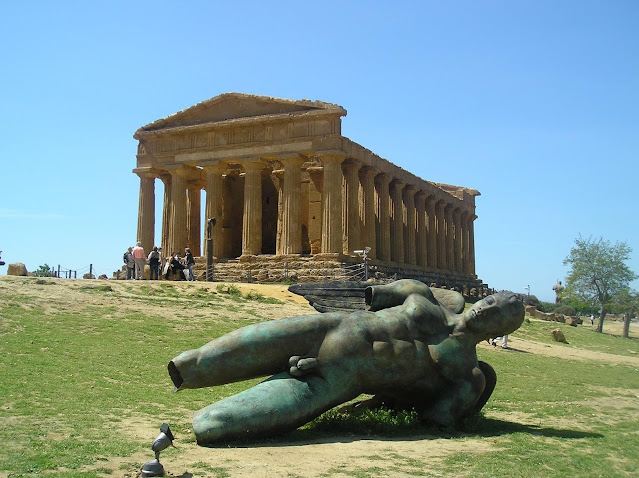Sicily's 7 UNESCO World Heritage Sites
A World Heritage Site is a landmark or area with legal protection by an international convention administered by the United Nations Educational, Scientific and Cultural Organization (UNESCO).
World Heritage Sites are designated by UNESCO for having cultural, historical, scientific or any other form of significance.
The sites are judged to contain "cultural" and "natural" heritage around the world which are considered to be of outstanding value for humanity.
To be selected a World Heritage Site must somehow have a unique landmark which is geographically and historically identifiable and have special cultural or physical significance. So it goes without saying that Sicily with its beauty, its rich history and culture and amazing geography is one of the places in the world that boasts many UNESCO World Heritage Sites.
Italy has a total of fifty five inscribed properties making it the country with the most World Heritage Sites, along with China, and seven of those are in Sicily, with one particular site boasting eight incredible towns.
So lets take a look at Sicily's UNESCO World Heritage Sites:
ARAB-NORMAN PALERMO & THE CATHEDRAL CHURCHES OF CEFALÙ & MONREALE (2015)
As Sicily's capital city, Palermo is located on the northern coast of Sicily.
Arab-Norman Palermo includes a series of nine civil and religious structures dating from the Norman era in Sicily, including two palaces, three churches, the city's cathedral, a bridge, as well as the Cathedrals of Cefalú and Monreale. Together they are examples of a multi cultural merging of Western, Islamic and Byzantine cultures on the island which gave rise to some of the most beautiful architectural structures and decor in the world. They also bear testimony to the fruitful co-existence of people from different origins and religions such as Muslims, Byzantines, Latin, Greeks and Normans.
Inscribed to the World Heritage list in 2015 the buildings and structures to look out for are the Royal Norman Palace and Palatine Chapel, the Church of San Giovanni degli Eremiti, the Church of Santa Maria dell'Ammiraglio (known as the Martorana), the Church of San Cataldo, Ziza Palace, the Cathedral of Palermo, the Admiral's Bridge and the Cathedrals of Cefalú and Monreale.
Norman rule of Sicily only lasted a century but it left a rich legacy of law, culture and architecture. Today what remains of earlier ages co-exists with modern life displaying a mixture of east and west.
The monuments of Arab-Norman Palermo are grouped around a fortified site in the heart of the city and the Cathedrals of Cefalù and Monreale are located within the Province of Palermo.
Find out more about these sites in these posts from my Blog archive:
"My Top 35 Palermo Tips" https://whitealmond-privatesicily.blogspot.com/2018/08/my-top-35-palermo-tips.html
"An Afternoon in Cefalù" https://whitealmond-privatesicily.blogspot.com/2019/08/an-afternoon-in-cefalu.html
MOUNT ETNA (2013)
Our beautiful volcano Mount Etna is one of the worlds most active volcanos and it is in an almost constant state of activity. Etna's fertile volcanic soils support extensive agriculture, with vineyards and fruit orchards and olive groves spread across the lower slopes of the volcano and the Plains of Catania.
Due to its history of recent activity and its nearby population, Mount Etna was designated a 'Decade Volcano' by the United Nations and in June 2013 it was added to the list of UNESCO World Heritage Sites.
Mount Etna dominates the eastern side of the island with several vast craters and a height of 3,330 metres. To the Greeks it was home to Hephaestus, god of fire, who used its flames and lava to forge Zeus's thunderbolts. To the Arabs it was known as 'Mongibello' (Beautiful Mountain).
For visitors it offers breath taking views, great hiking, wine tasting and jeep excursions plus you just might see an eruption of bright red sparks and lava.
Discover amazing things to do on Mount Etna in this post from my Blog archive:
"22 Ways to Experience Mount Etna" https://whitealmond-privatesicily.blogspot.com/2018/09/22-ways-to-experience-etna.html
SYRACUSE & THE NECROPOLIS AT PANTALICA (2005)
Inscribed as a World Heritage Site in 2005 this site is two separate elements containing outstanding vestiges dating back to Greek and Norman times.
The Necropolis of Pantalica contains over 5,000 tombs cut into rock near open stone quarries, most of the tombs date from the 13th to 7th centuries BC. Located 40km away from Syracuse the tombs are spread along a mountain range and also close by are the remains of dwellings dating from Greek colonisation.
The other part of the UNESCO site is Ancient Syracuse including the city's foundation of Ortigia which is situated on an island attached to the mainland by two bridges.
The site of the city, which Cicero described as "the greatest Greek city and the most beautiful of all" retains structures such as the Temple of Athena dating from the 5th century BC which was later transformed to serve as a Cathedral, a Greek theatre, a Roman amphitheatre, a fort and much more. Many remains bear witness to the troubled history of the island, from the Byzantines to the Bourbons, together with the Muslims, the Normans, the Hohenstaufen dynasty, the Aragon's and the Kingdom of the Two Sicilies. Historic Syracuse offers a unique testimony to the development of the Mediterranean civilization over three millennia.
The once mighty Greek colony and rival to Athens quietly exists today as a thriving modern city endowed with vestiges of its former glory. The ancient remains make up some of the most important sites in Sicily and the small historic centre of Ortigia is one of the most pleasant town centres on the island.
Discover Syracuse in these posts from my Blog archive:
"Syracuse ... The Island of Ortigia" https://whitealmond-privatesicily.blogspot.com/2015/03/syracuse-island-of-ortigia.html
"Syracuse ... The Archaeological Park" https://whitealmond-privatesicily.blogspot.com/2015/03/syracuse-archaeological-park.html
THE LATE BAROQUE TOWNS OF THE VAL DI NOTO (2002)
The settlements of the Val di Noto were completely destroyed by the enormous earthquake on the island in 1693.
Following the earthquake many towns were rebuilt on entirely new sites, such as Noto. The rulers of the time, Kings of Spain, granted the nobleman Giuseppe Lanza special authority to redesign the damaged towns, which he achieved by sympathetically designing the new towns in a Baroque and Renaissance style.
The new settlements were redesigned to have a town square in the centre and to spread out in a radial pattern from there. Major buildings like churches, cloisters and palaces were built as focal points for the new streets and the streets themselves were laid out in a grid pattern. Many of the individual towns were rebuilt to have a unique character.
In June 2002, UNESCO inscribed the towns of the Val di Noto on the World Heritage List as "representing the culmination and final flowering of Baroque art in Europe"
The listed towns are Caltagirone, Militello in Val di Catania, the City of Catania, Modica, Noto, Palazzolo Acreide, Ragusa and Scicli and all are a complete pleasure to visit.
Explore these towns in these posts from my Blog archive:
"Modica ... Churches and Chocolate" https://whitealmond-privatesicily.blogspot.com/2017/04/modica-churches-and-chocolate.html
"Ragusa Ibla" https://whitealmond-privatesicily.blogspot.com/2016/10/ragusa-ilba.html
"Noto" https://whitealmond-privatesicily.blogspot.com/2016/08/noto.html
"Scicli" https://whitealmond-privatesicily.blogspot.com/2015/10/scicli.html
"Caltagirone ... City of Ceramics" https://whitealmond-privatesicily.blogspot.com/2014/12/caltagirone-city-of-ceramics.html
THE AEOLIAN ISLANDS (2000)
The stunning Aeolian Islands are a volcanic archipelago in the Tyrrhenian Sea north of Sicily and they are named after the Greek demigod of the winds Aeolus. The islands are a popular tourist destination in the summer months and each precious one boasts its own character.
There are seven islands, Lipari, Vulcano, Salina, Stromboli, Filicudi, Alicudi and Panarea.
The Aeolian Islands were listed by UNESCO in 2000 as a World Heritage Site for providing "an outstanding record of ongoing volcanic phenomena".
With a mixture of history, small town atmosphere, intensely flavoured cuisine, natural beauty and glamour, the Aeolian Islands have a lot to offer their visitors.
Discover more about the Aeolian Islands in this Blog post from my archive:
"Sicily's Secret Islands" https://whitealmond-privatesicily.blogspot.com/2020/07/sicilys-secret-islands.html
THE ARCHAEOLOGICAL AREA OF AGRIGENTO (1997)
Founded as a Greek Colony in the 6th century BC, Agrigento became one of the leading cities in the ancient Mediterranean world. Its supremacy and pride are demonstrated by the remains of the Doric Temples that dominate the archaeological area much of which still lies intact.
The Archaeological Area of Agrigento became a World Heritage Site in 1997.
The famed Valle dei Templi (Valley of the Temples) is home to Greek Temples that stand, or partially stand, against a backdrop of the distant sea. They are as awe inspiring today as they must have been to the peoples who constructed them 2,500 years ago.
Views of the archaeological area are an unmissable sight on the island especially at sunset.
Discover Agrigento's famous almond blossom festival in this post from my Blog archive:
"The Almond Blossom Festival of Agrigento" https://whitealmond-privatesicily.blogspot.com/2019/02/the-almond-blossom-festival-of-agrigento.html
VILLA ROMANA DEL CASALE (1997)
The Villa Romana del Casale is a large and elaborate Roman villa located 3km from the town of Piazza Armerina.
Excavations have revealed one of the richest, largest and varied collections of Roman mosaics in the world, for which the site was designated a World Heritage Site in 1997.
The mosaic floors cover some 3,500 square metres and are almost unique in their excellent state of preservation due to a landslide and flood in the 12th Century which resulted in the villa being buried under mud.
Probably the most famous mosaics in the villa are the bikini clad athletes that appear to have just finished a competition with the winner being awarded a flowered crown and palm sceptre.
Discover more beautiful places to visit in Sicily in this post from my Blog archive:
"Where to go in Sicily ????" https://whitealmond-privatesicily.blogspot.com/2020/05/where-to-go-in-sicily.html
... and Finally,
although not a UNESCO World Heritage Site we also have the
OPERA DEI PUPI (2008)
The Sicilian puppet theatres were declared a UNESCO Masterpiece of Intangible Cultural Heritage of Humanity in 2008.
UNESCO established its lists of Intangible Cultural Heritage with the aim of ensuring better protection of important intangible cultural heritage worldwide and also the awareness of their significance.
The puppet theatre known as 'Opera dei Pupi' emerged in Sicily at the beginning of the 19th Century and enjoyed great success among the island's working classes. The puppeteers told stories based on medieval chivalric literature and other sources, such as Italian poems, the lives of saints and tales of notorious bandits. The two main Sicilian puppet schools in Palermo and Catania were distinguished principally by the size and the shape of the puppets, the operating techniques and the variety of colourful stage backdrops.
These theatres are often family run businesses. The carving, painting and construction of the puppets, which are renowned for their intense expressions, are carried out by craftspeople employing traditional methods.
A visit to a Sicilian puppet show is definitely a MUST Do on your visit to Sicily.
Find out what happened when we were invited to visit a Master Sicilian Puppet Maker in Catania in this post from my Blog archive:
"Pupi Salamanca ... the Master Puppet Maker" https://whitealmond-privatesicily.blogspot.com/2017/11/pupi-salamanca-master-puppet-maker.html

























